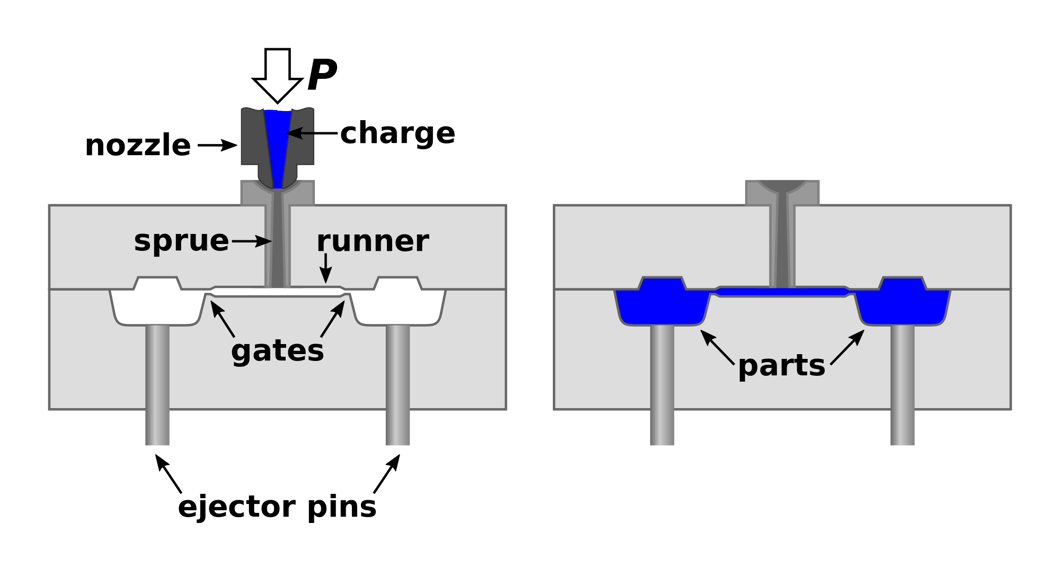There’s very rarely such a thing as a finished casting that comes straight from the mould. There’s always some amount of finishing work before the casting can be considered a finished product. In some cases, this could be simple surface finishing, such as powder coating, anodising or alochroming. However, in the vast majority of cases, there’s excess material to remove.
This excess material comes in a number of different forms on a gravity diecast part, such as sprues, flash and runners but what are they and why are they caused?
Sprues, Flash and Runners: You might be forgiven for mistaking these terms as positions in a Hogwarts Quidditch Team. Worry not, the mystery ends here. These terms are quite simply, three critical parts of the metal casting process.

Sprues
Sprues are a vital part of the gating system in gravity diecasting. A sprue is essentially a channel through which molten metal is poured into the mould. It starts wide at the top (pouring cup or basin) and narrows as it goes down, leading to the runners.
This tapering is essential as it ensures a smooth and controlled flow of the molten metal into the mould. Sprues aren't just about transferring molten metal, they're also about controlling its speed and pressure. Our sprues are always carefully designed and can prevent defects like mould erosion, incomplete filling, or trapped gas.
Runners
Runners are the next step for the still molten metal. They are horizontal channels that branch out from the sprue base, guiding the molten metal to the moulds. Runners may also be designed to feed multiple mould cavities. Like sprues, the design of runners plays a crucial role in the cast’s quality. Runners make sure of a smooth and uninterrupted flow keeping temperature loss to a minimum. We certainly don’t want the metal to harden until it’s fully within the mould.
Flash
Flash is a by-product of the casting process. It forms when molten metal seeps into the tiny gaps between the mould halves. As the metal cools and solidifies, it creates thin, excess layers around the cast's edges, known as flash. You might think this is a pain, but flash serves an important purpose: it tells us the mould has been completely and correctly filled, which is critical for producing defect-free casting.
Of course, we carefully remove this flash as part of the service. Although the removal, known as trimming, adds an extra step to the casting process it’s always a positive sign our casting has been successful, although if there is too much flash then it increases trimming cost, and may imply that pressure is being lost during the filling process as metal is escaping through the joint line.
EJECTOR PINS
Ejector pins are a necessary part of most castings and can be spotted if you know what you’re looking for. Ejector pins are small pins inside the mould that are used to ‘eject’ the casting and it’s running system when cooled. This is because a lot of castings are hard to remove without a little help and this vastly increases the speed that automated castings can be created.
Where the pin sits in the mould and the act of ‘ejecting’ the casting can leave a small imperfection, similar to flash, on the surface. These simply require a small surface finish to remove and at MRT we ensure that ejector pins are minimal and positioned discretely.
RISERS
Finally, risers are arguably the most interesting of the extracurricular parts that you might find within a gravity diecasting. They are specifically and precisely placed inside the mould attached to the cavity and helps prevent shrinkage. It’s essentially a large reservoir of molten material that is designed to solidify after the casting. If the casting shrinks during solidification, the still molten material in the riser above can fill in the cavity and ensure a perfect casting. Risers are not necessary with high pressure die casting methods, but are often used in sand and gravity die casting processes.
So now you know a little more about the intricacies of die casting. We’d love to talk more about the services we offer and you can be sure that whatever casting service you require, MRT will be there “in a flash” to help








